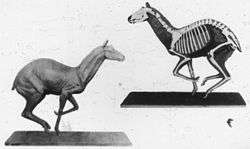Blastomeryx
| Blastomeryx Temporal range: Early Miocene–Late Pliocene | |
|---|---|
 | |
| Sculpture in cross section | |
| Scientific classification | |
| Kingdom: | Animalia |
| Phylum: | Chordata |
| Class: | Mammalia |
| Order: | Artiodactyla |
| Family: | Moschidae |
| Subfamily: | †Blastomerycinae |
| Genus: | †Blastomeryx Cope, 1877 |
| Species: | †B. gemmifer |
| Binomial name | |
| Blastomeryx gemmifer (Cope, 1877) | |
| Synonyms | |
| |
Blastomeryx is an extinct genus of musk deer of the family Moschidae, subfamily Blastomerycinae, endemic to North America during the Oligocene-Miocene epochs (24.8—10.3 mya), existing for approximately 14.5 million years.[1] There is only one species, Blastomeryx gemmifer.[2]
Morphology

It was 75 cm (2 ft 6 in) long and looked like a modern chevrotain. Its canines were elongated into tusks which it probably used to uproot plants and fend off predators. While most species of Blastomeryx (as well as modern musk deer) lacked antlers, a Late Miocene species had bony knobs on its skull, which have been interpreted as incipient horns.[3]
Body mass
Two specimens were examined by M. Mendoza for body mass. The first specimen was estimated to have a weight of 55 kg (120 lb). The second specimen was estimated to have a weight of 16 kg (35 lb).[4]
References
- ↑ PaleoBiology Database: Blastomeryx, basic info
- ↑ Prothero, 2007 (p. 221-226)
- ↑ Palmer, D., ed. (1999). The Marshall Illustrated Encyclopedia of Dinosaurs and Prehistoric Animals. London: Marshall Editions. p. 273. ISBN 1-84028-152-9.
- ↑ M. Mendoza, C. M. Janis, and P. Palmqvist. 2006. Estimating the body mass of extinct ungulates: a study on the use of multiple regression. Journal of Zoology